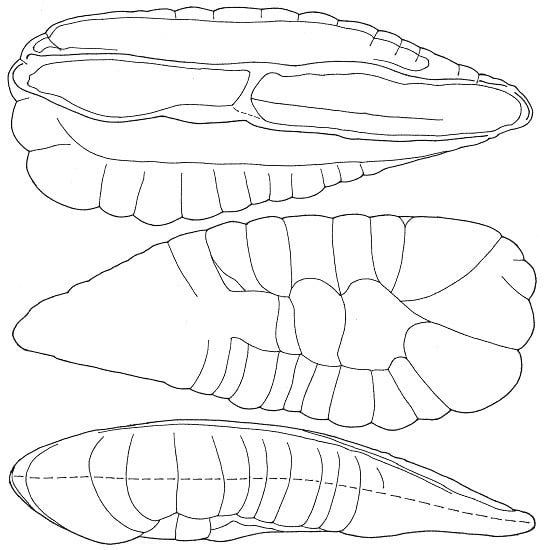Taxonomy, Distribution and Evolution of Trisopterine Gadidae by Means of Otoliths and Other Characteristics
Abstract
:1. Introduction
2. Results, Including a Survey of Characteristics of Recent Trisopterines
2.1. Factors Influencing Otolith Shape
2.2. Characteristics of Gadidae Otoliths
2.3. Otolith Characteristics of Recent Trisopterine Gadidae
- Pear shaped (also in Gadiculus-like and extinct Colliolus-like otoliths)
- Thick, especially the adult otoliths
- Sulcus (very) wide
- Colliculi long and wide, largely filling sulcus and touching one another
- Collum only at ventral part of sulcus
- Pseudocolliculum absent
2.4. Other Characteristics of Trisopterine Gadidae
2.5. Neocolliolus: A Justifiable Taxon in the Gadidae Family
2.5.1. Introductory remarks
2.5.2. Amended otolith diagnosis of Neocolliolus
2.5.3. Other distinguishing characteristics of Neocolliolus
2.6. Trisopterus capelanus Is a Separate Species
2.7. Allotrisopterus, a New Genus for Trisopterus Minutus
2.7.1. Allotrisopterus n. gen.
2.7.2. Remarks of justification
2.8. Otoliths from Bottom Samples of the Ría de Arosa (north-western Spain)
2.9. Geographical and Depth Distribution
2.10. Evolution of Trisopterines
3. Discussion and Conclusions
4. Materials and Methods
4.1. Recent Otoliths
4.2. Fossil Otoliths
4.3. Picturing and Measuring
4.4. Taxon Validation
Acknowledgments
Conflicts of Interest
Abbreviations
| TL | Total fish length in mm |
| FW | Total fish weight in g |
| OL | Otolith length in mm |
| OH | Otolith height (width) in mm |
| OT | Otolith thickness in mm |
References
- Svetovidov, A.N. Fauna SSSR: Ryby, (n.s. 34), Vol. 9, Fasc. 4; Treskoobraznye [Gadiformes]: Zoologicheskii lnstitut Akademi Nauk SSSR, Moscow-Leningrad, Russia, 1948; p. 294. [Google Scholar]
- Svetovidov, A.N. Fauna of the U.S.S.R., Fishes, Gadiformes; Zoologicheskii Institut, Akademii Nauk SSSR, Published by Israel Program for Scientific Translations: Jerusalem, Israel, 1962; Volume 9, vip. 304p. [Google Scholar]
- Gaemers, P.A.M. New concepts in the evolution of the Gadidae (Vertebrata, Pisces), based on their otoliths. Meded. Werkgr. Tert. Kwart. Geol. 1976, 13, 3–32. [Google Scholar]
- Nolf, D.; Steurbaut, E. Importance and restrictions of the otolith-based fossil record of gadiform and ophidiiform fishes. In Papers on the Systematics of Gadiform Fishes; Cohen, D.M., Ed.; Science Series; Natural History Museum of the Los Angeles County: Los Angeles, CA, USA, 1989; Volume 32, pp. 47–58. [Google Scholar]
- Endo, H. Phylogeny of the order Gadiformes (Teleostei, Paracanthopterygii). Mem. Grad. School Fish. Sci. Hokkaido Univ. 2002, 49, 75–149. [Google Scholar]
- Nelson, J.S. Fishes of the World, 4th ed.; John Wiley and Sons: Hoboken, NJ, USA, 2006; p. 624. [Google Scholar]
- Teletchea, F.; Laudet, V.; Hänni, C. Phylogeny of the Gadidae (sensu Svetovidov, 1948) based on their morphology and two mitochondrial genes. Mol. Phylogen. Evol. 2006, 38, 189–199. [Google Scholar] [CrossRef] [PubMed]
- Roa-Varón, A.; Ortí, G. Phylogenetic relationship among families of Gadiformes (Teleostei, Paracanthopterygii) based on nuclear and mitochondrial data. Mol. Phylogen. Evol. 2009, 52, 688–704. [Google Scholar] [CrossRef] [PubMed]
- Howes, G.J. Anatomy of the Melanonidae (Teleostei: Gadiformes), with comments on its phylogenetic relationships. Bull. Nat. Hist. Mus. (Zool.) 1993, 59, 11–31. [Google Scholar]
- Fahay, M.P. Early Stages of Fishes in the Western North Atlantic Ocean (Davis Strait, Southern Greenland and Flemish Cap to Cape Hatteras). Volume 1. Acipenseriformes through Syngnathiformes; NW Atl. Fish. Org.: Dartmouth, NS, Canada, 2007; p. 931. [Google Scholar]
- Eschmeyer, W.N. (Ed.) Catalog of Fishes. Updated Internet Version of 31 October 2014. Catalog Databases of CAS Cited in FishBase. Available online: http://researcharchive.calacademy.org/research/ichthyology/catalog/fishcatmain.asp (accessed on 11 December 2014).
- Gill, T.P. On the Family Ranicipitidae. Proceedings of the United States National Museum; U.S. Government Printing Office: Washington, DC, USA, 1890; Volume 13, pp. 1–4.
- Jordan, A.D.; Møller, P.R.; Nielsen, J.G. Revision of the Arctic cod genus Arctogadus. J. Fish Biol. 2003, 62, 1339–1352. [Google Scholar] [CrossRef]
- Byrkjedal, I.; Rees, D.J.; Christiansen, J.S.; Fevolden, S.-E. The taxonomic status of Theragra finnmarchica Koefoed, 1956 (Teleostei: Gadidae): Perspectives from morphological and molecular data. J. Fish Biol. 2008, 73, 1183–1200. [Google Scholar] [CrossRef]
- Svetovidov, A.N. Gadidae. In Check-List of the Fishes of the North-Eastern Atlantic and of the Mediterranean; Hureau, J.-C., Monod, T., Eds.; UNESCO: Paris, France, 1973; Volume 1, pp. 303–320. [Google Scholar]
- Svetovidov, A.N. Gadidae. In Fishes of the North-Eastern Atlantic and the Mediterranean; Whitehead, P.J.P., Bauchot, M.-L., Hureau, J.-C., Nielsen, J., Tortonese, E., Eds.; UNESCO: Paris, France, 1986; Volume 2, pp. 680–710. [Google Scholar]
- Schmidt, E.J. Gadiculus argenteus and Gadiculus thori. In Mindeskrift i Anledning af Hundredaaret for Japetus Steenstrups Fødsel; En kreds af Naturforskere: Copenhagen, Denmark, 1913; Volume 14, p. 9. [Google Scholar]
- Mattiangeli, V.; Bourke, E.A.; Ryan, A.W.; Mork, J.; Cross, T.F. Allozyme analyses of the genus Trisopterus: Taxonomic status and population structure of the poor cod. J. Fish Biol. 2000, 56, 474–494. [Google Scholar] [CrossRef]
- Mattiangeli, V.; Galvin, P.; Ryan, A.W.; Mork, J.; Cross, T.F. VNTR variability in Atlantic poor cod (Trisopterus minutus minutus) throughout its range: Single locus minisatellite data suggest reproductive isolation for the Faroe Bank population. Fish Res. 2002, 58, 185–191. [Google Scholar] [CrossRef]
- Mattiangeli, V.; Ryan, A.W.; Galvin, P.; Mork, J.; Cross, T.F. Eastern and western poor cod (Trisopterus minutus capelanus) populations in the Mediterranean Sea: Evidence from allozyme and minisatellites loci. Mar. Ecol. 2003, 24, 247–258. [Google Scholar] [CrossRef]
- Delling, B.; Noren, M.; Kullander, S.O.; González, J.A. Taxonomic review of the genus Trisopterus (Teleostei: Gadidae) with recognition of the capelan Trisopterus capelanus as a valid species. J. Fish Biol. 2011, 79, 1236–1260. [Google Scholar] [CrossRef] [PubMed]
- Gonzalez, E.G.; Cunha, R.L.; Sevilla, R.G.; Ghanavi, H.R.; Krey, G.; Bautista, J.M. Evolutionary history of the genus Trisopterus. Mol. Phylogenet. Evol. 2012, 62, 1013–1018. [Google Scholar] [CrossRef] [PubMed]
- Gaemers, P.A.M.; Crapon de Crapona, M.-D. Sexual dimorphism in otoliths of haplochromines (Pisces, Cichlidae). Ann. Mus. Roy. Afr. Cent. Sci. Zool. 1986, 251, 151–155. [Google Scholar]
- Gaemers, P.A.M. The biostratigraphy of the Nieder Ochtenhausen borehole based on Gadidae otoliths and other fish remains, and the establishment of the Elbian, a new stage for the latest Late Miocene of NW Europe. Geol. Jahrb. 2001, 152, 301–339. [Google Scholar]
- Härkönen, T. Guide to the Otoliths of the Bony Fishes of the Northeast Atlantic, 1st ed.; Danbiu ApS.: Hellerup, Denmark, 1986; p. 256. [Google Scholar]
- Schwarzhans, W. Otolith-morphology and its usage for higher systematical units, with special reference to the Myctophiformes s.l. Meded. Werkgr. Tert. Kwart. Geol. 1978, 15, 167–185. [Google Scholar]
- Nolf, D.; Steurbaut, E. Evidence from otoliths for establishing relationships between gadiforms and other groups. In Papers on the Systematics of Gadiform Fishes; Cohen, D.M., Ed.; Science Series; Natural History Museum of the Los Angeles County: Los Angeles, CA, USA, 1989; Volume 32, pp. 37–45. [Google Scholar]
- Lambert, G.; Nielsen, J.R.; Larsen, L.I.; Sparholt, H. Maturity and growth population dynamics of Norway pout (Trisopterus esmarkii) in the North Sea, Skagerrak, and Kattegat. ICES J. Mar. Sci. 2009, 66, 1899–1914. [Google Scholar] [CrossRef]
- Lambert, G. Norway pout (Trisopterus esmarkii) life history strategy: Growth and maturity as evidence of possible spawning mortality. In Mémoire de fin d’études Pour l’obtention du Diplôme d’Agronomie Approfondie » (DAA) Spécialisation Halieutique; Agrocampus Rennes: Rennes, France, 2007; p. 75. [Google Scholar]
- Raitt, D.F.S. Synopsis of the Biological Data on the Norway Pout Trisopterus esmarkii (Nilsson, 1855); FAO Fish Synopsis: Rome, Italy, 1968; Volume 33, pp. 1–36. [Google Scholar]
- Saemundsson, B. On the age and growth of the coalfish (Gadus virens L.), the Norway pout (Gadus esmarkii Nilsson) and the poutassou (Gadus poutassou Risso) in Icelandic waters. Meddel. Komm. Danm. Fisk. Havunders. 1929, 8, 1–37. [Google Scholar]
- Baranenkova, A.S.; Khokhlina, N.S. Distribution of eggs, larvae and adults of the Norway pout off northwestern Norway and in the Barents Sea. Rap. Proc.-Verb. Réun. Cons. Internatl. Explor. Mer 1968, 158, 90–100. [Google Scholar]
- Magnussen, E.; Magnussen, M.D. Ecology of poor-cod (Trisopterus minutus) on the Faroe Bank. Mar. Biol. Res. 2009, 5, 133–142. [Google Scholar] [CrossRef]
- Cooper, A. The reproductive biology of poor cod, Trisopterus minutus L., whiting, Merlangius merlangus L., and Norway pout, Trisopterus esmarkii Nilsson, off the west coast of Scotland. J. Fish Biol. 1983, 22, 317–334. [Google Scholar] [CrossRef]
- Merayo, C.R. Reproduction and fecundity of the bib Trisopterus luscus (Linnaeus, 1758) (Pisces, Gadidae) in the central region of the Cantabrian Sea (northern Spain). Bol. Inst. Esp. Oceanogr. 1996, 12, 17–29. [Google Scholar]
- Labarta, U.; Ferreiro, M.J. Age and Growth of the Galician Coast Pouting (Trisopterus luscus L.) Preliminary Data; CM1982/g:65; ICES: Copenhagen, Denmark, 1982. [Google Scholar]
- Alonso-Fernández, A.; Domínguez-Petit, R.; Bao, M.; Rivas, C.; Saborido-Rey, F. Spawning pattern and reproductive strategy of female pouting Trisopterus luscus (Gadidae) on the Galician shelf of north-western Spain. Aquat. Living Resour. 2008, 21, 383–393. [Google Scholar] [CrossRef]
- Recordlijst zeevissen Nederland per 1 Januari 2013 (Nederland. Continentaal Plat). [Record List of Sea Fishes Netherlands at 1 January 2013, Continental Shelf of The Netherlands]. Available online: http://www.ncrz.nl/pdf/NCRZ_lijst_NL.pdf (accessed on 11 December 2014).
- Ragonese, S.; Bianchini, M.L. Growth, Mortality and Yield-per-Recruit of the Poor Cod Trisopterus minutus Capelanus, from the Strait of Sicily; Naga, Iclarm Quarterly Fishbyte Section: Penang, Malaysia, 1998; pp. 61–70. [Google Scholar]
- Šantić, M.; Pallaoro, A.; Mikulandra, I.; Rađa, B.; Jardas, I. Age, growth and mortality of poor cod (Trisopterus minutus L.) from the eastern Adriatic Sea. Arch. Biol. Sci. 2015, 11. [Google Scholar] [CrossRef]
- Metin, G.; Ilkyaz, A.T.; Kınacıgil, H.T. Growth, mortality, and reproduction of poor cod (Trisopterus minutus Linn., 1758) in the Central Aegean Sea. Turk. J. Zool. 2008, 32, 43–51. [Google Scholar]
- Biagi, F.; de Ranieri, S.; Viva, C. Recruitment, length at first maturity and feeding of poor-cod, Trisopterus minutus capelanus, in the northern Tyrrhenian Sea. Ital. J. Zool. 1992, 59, 87–93. [Google Scholar]
- Carpenter, K.E.; Stump, E. Trisopterus capelanus. In The IUCN Red List of Threatened Species; Version 2014.3; International Union for Conservation of Nature and Natural Resources: Gland, Switzerland, 2014. [Google Scholar]
- Albert, O.T. Biology and ecology of Norway pout (Trisopterus esmarki Nilsson, 1855) in the Norwegian Deep. ICES J. Mar. Sci. 1994, 51, 45–61. [Google Scholar] [CrossRef]
- Wheeler, A. Key to the Fishes of Northern Europe; Frederick Warne Ltd.: London, UK, 1978; xixp. 380p. [Google Scholar]
- Potter, I.C.; Claridge, P.N.; Warwick, R.M. Consistency of seasonal changes in an estuarine fish assemblage. Mar. Ecol. Progr. Ser. 1986, 32, 217–228. [Google Scholar] [CrossRef]
- Albert, O.T. Biology and Ecology of Norway Pout (Trisopterus esmarkii) in the Norwegian Deep; C.M. 1991/G:44; ICES Demersal Fish Comm.: Copenhagen, Denmark, 1991; p. 31. [Google Scholar]
- Gibson, R.N.; Robb, L.; Burrows, M.T.; Ansell, A.D. Tidal, diel and longer term changes in the distribution of fishes on a Scottish sandy beach. Mar. Ecol. Progr. Ser. 1996, 130, 1–17. [Google Scholar] [CrossRef]
- Cohen, D.M.; Inada, T.; Iwamoto, T.; Scialabba, N. FAO species catalogue. Gadiform fishes of the world (Order Gadiformes). In An Annotated and Illustrated Catalogue of Cods, Hakes, Grenadiers and other Gadiform Fishes Known to Date; FAO Fisheries Synopsis: Rome, Italy, 1990; Volume 125, xp. 442p. [Google Scholar]
- Froese, R.; Pauly, D. (Eds.) FishBase. World Wide Web Electronic Publication, Version 2015. Trisopterus minutus (Linnaeus, 1758), Poor Cod.. Available online: http://www.fishbase.org/summary/481 (accessed on 19 August 2015).
- Jardas, I. Adriatic Ichthyofauna; Školska knjiga d.d.: Zagreb, Kroatia, 1996; p. 523. (In Croatian) [Google Scholar]
- Di Natale, A.; Molinari, A.; Öztúrk, B.; Srour, A. The IUCN Red List of Threatened Species. Trisopterus capelanus. Available online: http://www.iucnredlist.org/details/49911704/0 (accessed on 19 August 2015).
- Labropoulou, M.; Papaconstantinou, C. Community structure of deep-sea demersal fish in the North Aegean Sea (northeastern Mediterranean). Hydrobiology 2000, 440, 281–296. [Google Scholar] [CrossRef]
- Politou, C.-Y.; Papaconstantinou, C. Population biology of Trisopterus minutus capelanus (Gadidae) from the eastern coast of Greece. Cybium 1991, 15, 69–81. [Google Scholar]
- Gaemers, P.A.M. New gadiform otoliths from the Tertiary of the North Sea Basin and a revision of some fossil and recent species. Leidse Geol. Meded. 1976, 49, 507–537. [Google Scholar]
- Raitt, D.F.S. The Food and Feeding of Gadus Esmarkii (Nilsson) Compared with 0-Group Haddock and Whiting; ICES CM 1961/Gadoid Committee Mar. Res., No. 101; ICES: Copenhagen, Denmark, 1961. [Google Scholar]
- Raitt, D.F.S. Observations on the population dynamics of the Norway pout in the North Sea. Rap. Proc. Verb. Cons. Perm. Internatl. Explor. Mer 1968, 158, 85–90. [Google Scholar]
- Linnaeus, C. Systema Naturae per Regna Tria Naturae, Secundum Classes, Ordinus, Genera, Species, Cum Characteribus, Differentiis, Synonymis, Locis, 10th ed.; Lars Salvi: Stockholm, Sweden, 1758; Volume 1, p. 824. [Google Scholar]
- Artedi, P. Ichthyologia, sive opera omnia de piscibus scilicet: Bibliotheca ichthyologica. Philosophia ichthyologica. Genera Piscium, Synonymia specierum, Descriptiones specierum. Omnia in hoc genere perfectiora, quam antea ulla. Posthuma. In Vindicavit, Recognovit, Coaptavit & Editit Carolus Linnæus, Med. Doct. & Ac. Imper. N.C.; Conradum Wishoff: Leiden, The Netherlands, 1738; Volume 3, ivp. 88p. [Google Scholar]
- Müller, O.F. Zoologiae Danicae Prodromus, seu Animalium Daniae et Norvegiae Indigenarum Characteres, Nomina, et Synonyma Imprimis Popularium; Hallager: Copenhagen, Denmark, 1776; xxxiip. 282p. [Google Scholar]
- Lacepède, B. Histoire Naturelle des Poisons; Plassan: Paris, France, 1800; Volume 2, lxivp. 632p. [Google Scholar]
- Rafinesque-Schmaltz, C.S. Précis des Découvertes et Travaux Somiologiques de Mr. C.S. Rafinesque-Schmaltz Entre 1800 et 1814; Ou choix raisonné de ses principales Découvertes en Zoologie et en Botanique pour servir d’introduction à ses ouvrages futurs; Royale Typographie Militaire: Palermo, Italy, 1814; p. 55. [Google Scholar]
- Risso, A. Histoire Naturelle des Principales Productions de l’Europe Méridionale et Particulièrement de Celles des Environs de Nice et des Alpes Maritimes; Levrault: Paris et Strasbourg, Croatia, 1826; Volume 3, xvip. 486p. [Google Scholar]
- Schwarzhans, W. The Otoliths from the Miocene of the North Sea Basin; Backhuys Publishers: Leiden, The Netherlands; Margraf Publishers: Weikersheim, Germany, 2010; vp. 352p. [Google Scholar]
- Tuset, V.M.; Lombarte, A.; Assis, C.A. Otolith atlas for the western Mediterranean, north and central eastern Atlantic. Sci. Mar. 2008, 72S1, 7–198. [Google Scholar]
- Fage, L. Le Capelan de la Méditerranée: Gadus capelanus (Risso) et ses rapports avec les espèces voisines: G. luscus Linné et G. minutus O. Fr. Müller. Arch. Zool. Exp. Génér. Hist. Nat. Morphol. Histol. Évol. Anim. 1911, 6, 257–282. [Google Scholar]
- Chaine, J.; Duvergier, J. Distinction des Gadus capelanus, minutus et luscus par leur sagittae. Compt. Rend. Hebdom. Séanc. Acad. Sci. Paris 1927, 184, 977–978. [Google Scholar]
- Merayo, C.R.; Villegas, M.L. Age and growth of Trisopterus luscus (Linnaeus, 1758) (Pisces, Gadidae) off the coast of Asturias. Hydrobiologia 1994, 281, 115–122. [Google Scholar] [CrossRef]
- Zhang, D.-X.; Smith, J.-A.; Rico, C.; Hewitt, G.M. Isolation and characterization of 10 microsatellite loci in poor cod Trisopterus minutus (L). Mol. Ecol. Notes 2001, 1, 50–52. [Google Scholar] [CrossRef]
- Carr, S.M.; Kivlichan, D.S.; Pepin, P.; Crutcher, D.C. Molecular systematics of gadid fishes: Implications for the biogeographic origins of Pacific species. Can. J. Zool. 1999, 7, 19–26. [Google Scholar] [CrossRef]
- Cadée, G.C. Molluscan biocoenoses and thanatocoenoses in the Ría de Arosa, Galicia, Spain. Zool. Verhand. Rijksmus. Nat. Hist. Leiden 1968, 95, 1–121. [Google Scholar]
- Froese, R.; Pauly, D. (Eds.) FishBase. World Wide Web Electronic Publication, Version 2015. Trisopterus luscus (Linnaeus, 1758), Pouting. Available online: http://www.fishbase.org/summary/1367 (accessed on 19 August 2015).
- FAO Aquatic Species Distribution Map of Trisopterus luscus. Available online: http://www.fao.org/fishery/species/2235/en (accessed on 19 August 2015).
- Assis, C. Guia para a Identificação de Algumas Famílias de Peixes Ósseos de Portugal Continental, Através da Morfologia dos Seus Otólitos Sagitta; Prémio do Mar Rei D. Carlos, Câmara Municipal de Cascais: Cascais, Portugal, 2004; p. 190. [Google Scholar]
- Andrade da Silva, D.M. Discrimination of Trisopterus luscus (Linnaeus 1758) stocks in the northern of Portugal using otolith elemental fingerprints. Master’s Thesis, University of Porto, Porto, Portugal, 2010; p. 34. [Google Scholar]
- Magnussen, M.D. Ecology of poor cod (Trisopterus minutus) on the Faroe Bank. Bachelor’s Thesis, University of the Faroe Islands, Tórshavn, Faroe Islands, 2004; p. 37. [Google Scholar]
- Froese, R.; Pauly, D. (Eds.) FishBase. Computer Generated Map for Trisopterus minutus (Poor Cod). Available online: www.aquamaps.org (accessed on 11 December 2014).
- Hognestad, P.T.; Vader, W. Saltvannsfiskene i Nord-Norge (The species of marine fishes in North Norway). Tromura 1979, 6, 1–74. [Google Scholar]
- Gomes, M.C.; Serrão, E.; de Fátima Borges, M. Spatial patterns of groundfish assemblages on the continental shelf of Portugal. ICES J. Mar. Sci. 2001, 58, 633–647. [Google Scholar] [CrossRef]
- Froese, R.; Pauly, D. (Eds.) FishBase, Computer Generated Map for Trisopterus esmarkii (Norway Pout). Available online: www.aquamaps.org (accessed on 11 December 2014).
- Mikkelsen, G. Changes in Norway Pout (Trisopterus esmarkii) Abundance and Distribution under Warming Conditions in the Barents Sea. Master’s Thesis, University of Bergen, Bergen, Norway, 2014. [Google Scholar]
- ICES. Report of the ICES Advisory Committee, 2008. Book 7. Bay of Biscay and Western Iberian Seas; ICES: Copenhagen, Denmark, 2008; p. 122. [Google Scholar]
- Nolf, D. The Diversity of Fish Otoliths, Past and Present; Steurbaut, E., Brzobohaty, R., Hoedemakers, K., Eds.; Roy. Belg. Inst. Nat. Sci.: Brussels, Belgium, 2013; p. 222, + 359 plates. [Google Scholar]
- Gaemers, P.A.M. A biozonation based on Gadidae otoliths for the northwest European younger Cenozoic, with the description of some new species and genera. Meded. Werkgr. Tert. Kwart. Geol. 1978, 1, 141–161. [Google Scholar]
- Gaemers, P.A.M. Otolith biostratigraphy and paleoecology of well Eidelstedt-1, Nordgetränke (Hamburg Area, F.R.G.), and comparison with some other Langenfeldian and Gramian otolith faunas in the North Sea Basin. Meded. Werkgr. Tert. Kwart. Geol. 1978, 2, 95–118. [Google Scholar]
- Gaemers, P.A.M. Otoliths (Gadidae). The description of the interregional zonation (otolith zones) and its stratigraphical consequences. The regional distribution of otolith assemblages; correlation of the interregional zonation with the regional lithostratigraphic formations. In The Northwest European Tertiary Basin. Results of the International Geological Correlation Programme Project No 124; Vinken, R., Ed.; Geol. Jahrb., German Geological Survey BGR: Hannover, Germany, 1988; Volume 100, pp. 369–390. [Google Scholar]
- Gaemers, P.A.M. Refined correlations by means of lithostratigraphy and gadid otolith zonation of the Rupelian of the North Sea Basin: A progress report. Bull. Soc. Belge Géol. 1994, 10, 147–157. [Google Scholar]
- Hennig, W. Grundzüge einer Theorie der Phylogenetischen Systematik; Deutscher Zentralverlag: Berlin, Germany, 1950; p. 370. [Google Scholar]
- Grantham, T. The role of fossils in phylogeny reconstruction: Why is it so difficult to integrate paleobiological and neontological evolutionary biology? Biol. Philos. 2004, 19, 687–720. [Google Scholar] [CrossRef]
- Gaemers, P.A.M. A revision of the Gadidae otoliths (Pisces) from the Redonian of the Ligerian Gulf (NW France) and the stratigraphic position of the Redonian. Tert. Res. 1987, 8, 105–125. [Google Scholar]
- Lanckneus, J.; Nolf, D. Les otolithes des téléostéens redoniens de Bretagne (Néogène de l’Ouest de la France). Bull. Inst. Géol. Bassin Aquit. 1979, 25, 83–109. [Google Scholar]
- Hoedemakers, K. Teleost fish otoliths from the Neogene of Mill-Langenboom (province of Noord-Brabant, The Netherlands. Cainozoic Res. 2013, 10, 35–52. [Google Scholar]
- Tirard, C.; Berrebi, P.; Raibaut, A.; Frenaud, F. Parasites as biological markers—Evolutionary relationships in the heterospecific combination of helminths (monogeans) and teleosts (Gadidae). Biol. J. Linn. Soc. 1992, 47, 173–182. [Google Scholar] [CrossRef]
- Gaemers, P.A.M.; Poulsen, J.Y. Recognition and distribution of two Gadiculus species, G. argenteus and G. thori, based on otolith morphology, larval pigmentation and molecular evidence. J. Fish Biol. 2016, in press. [Google Scholar]

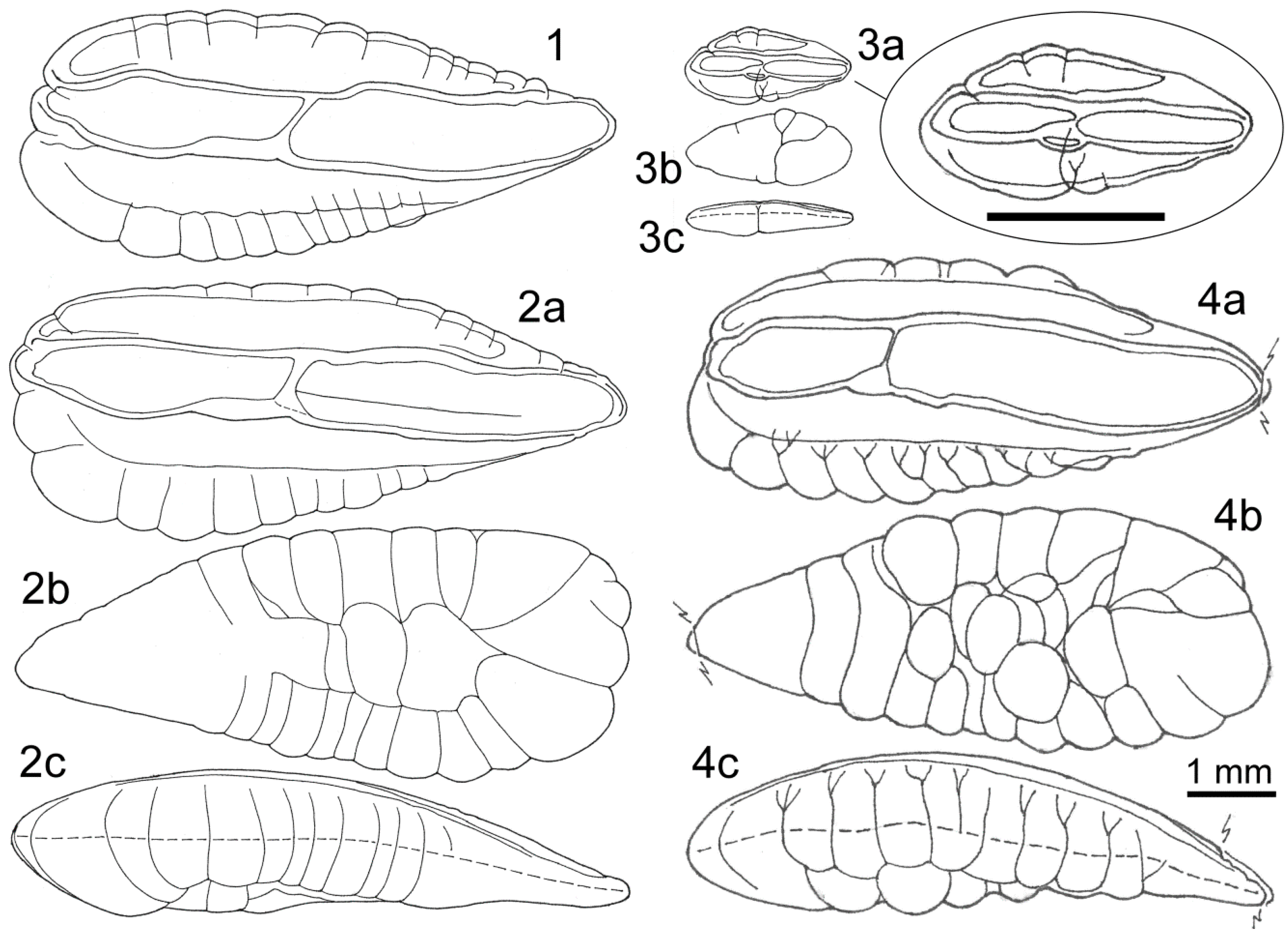



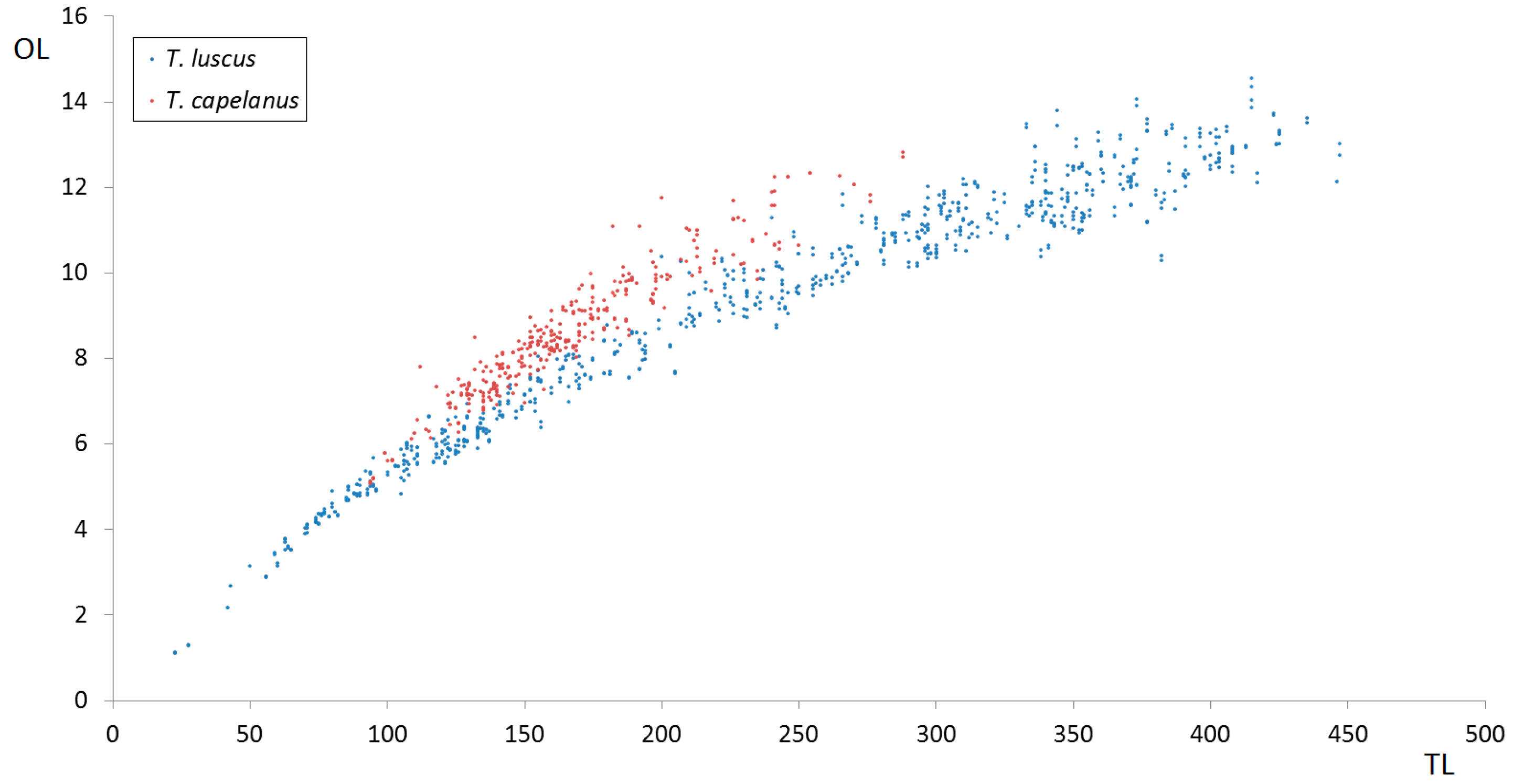
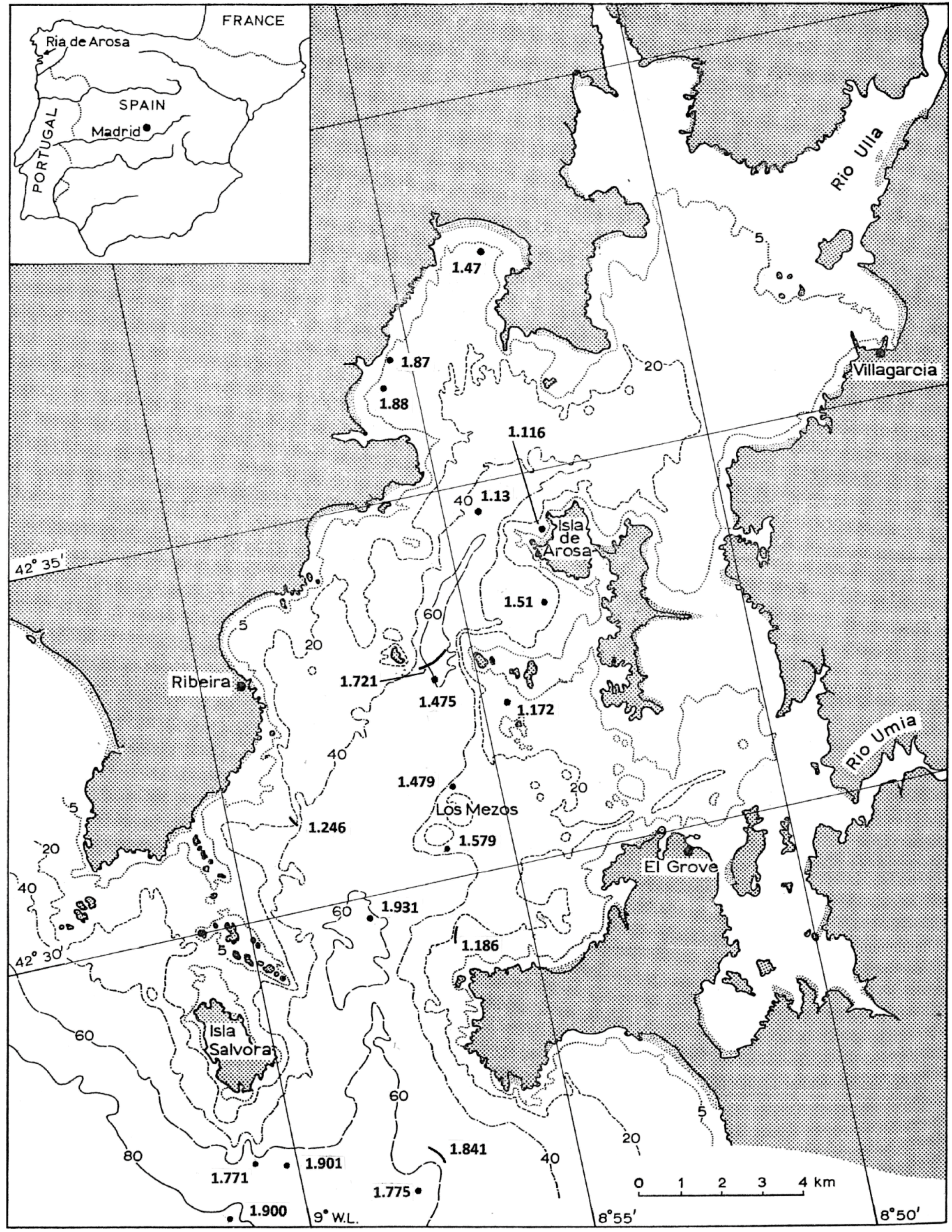
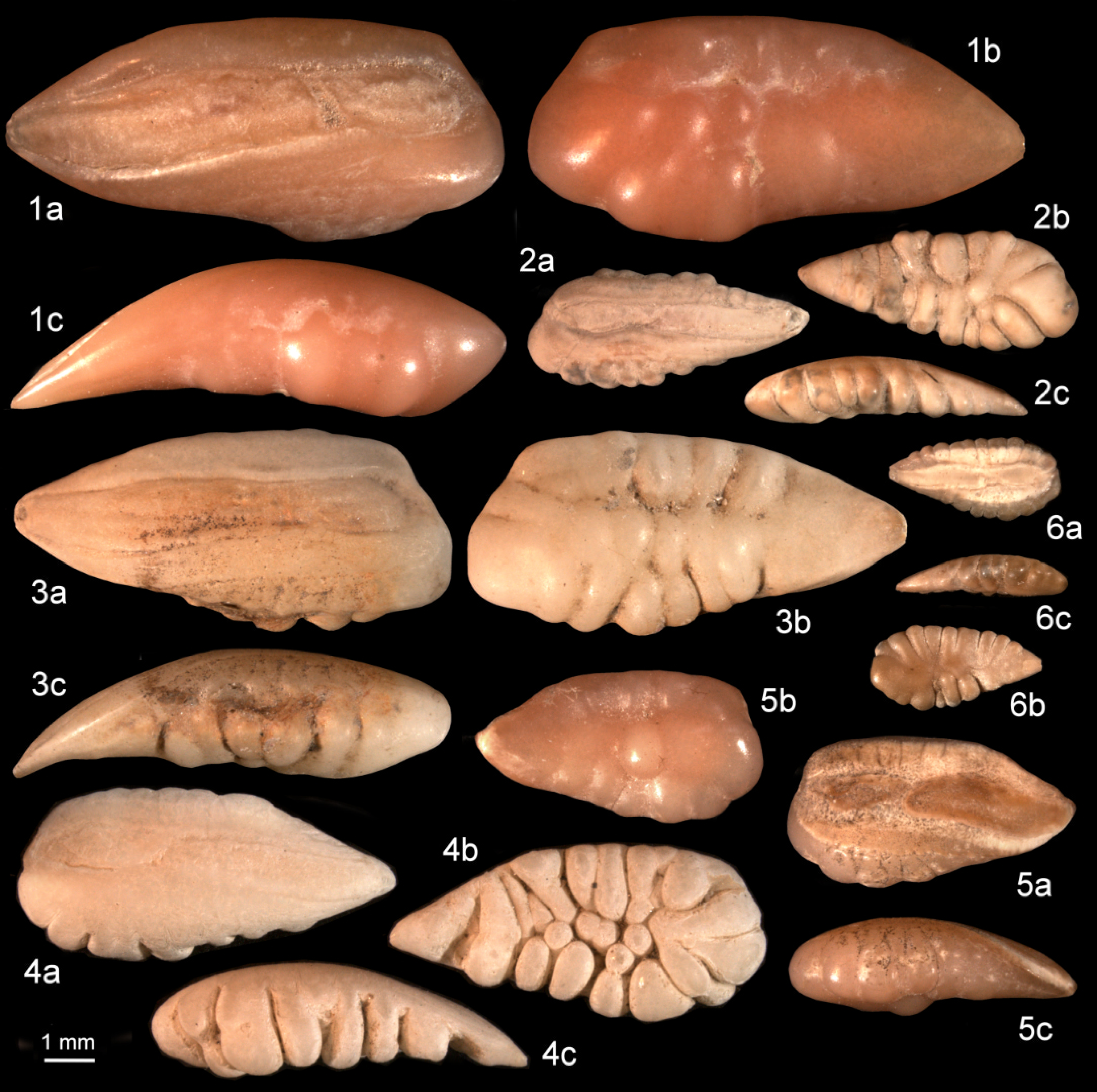
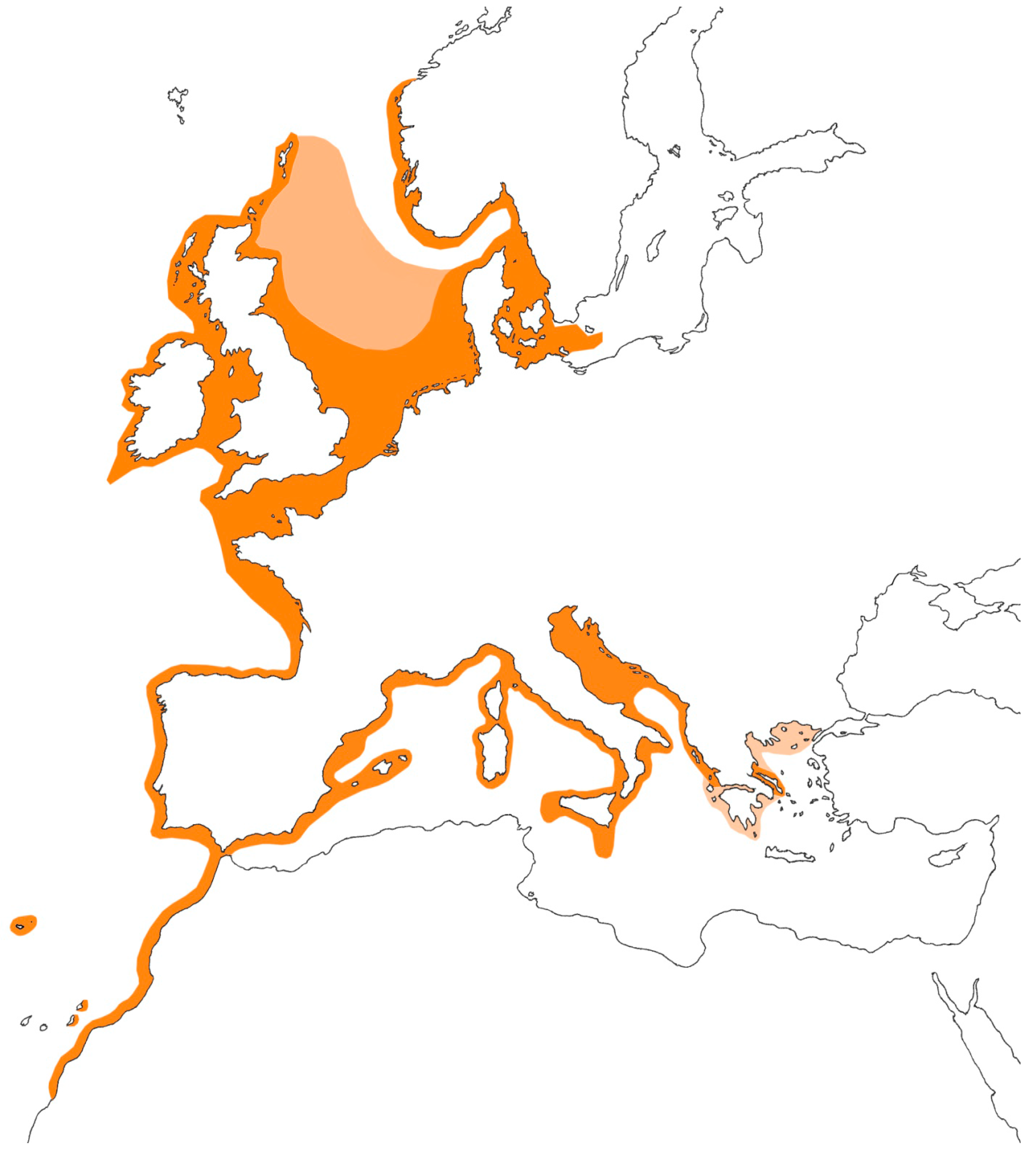
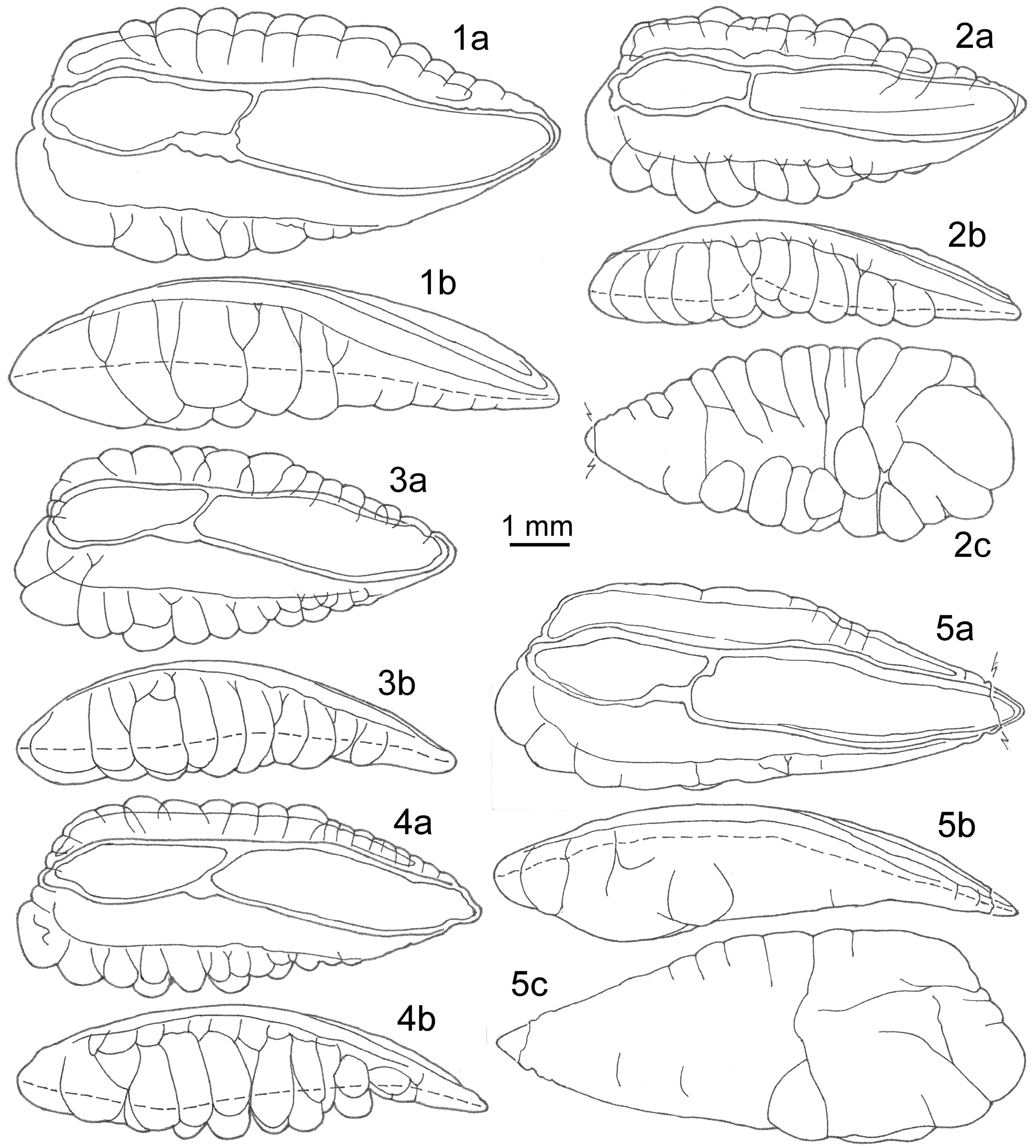
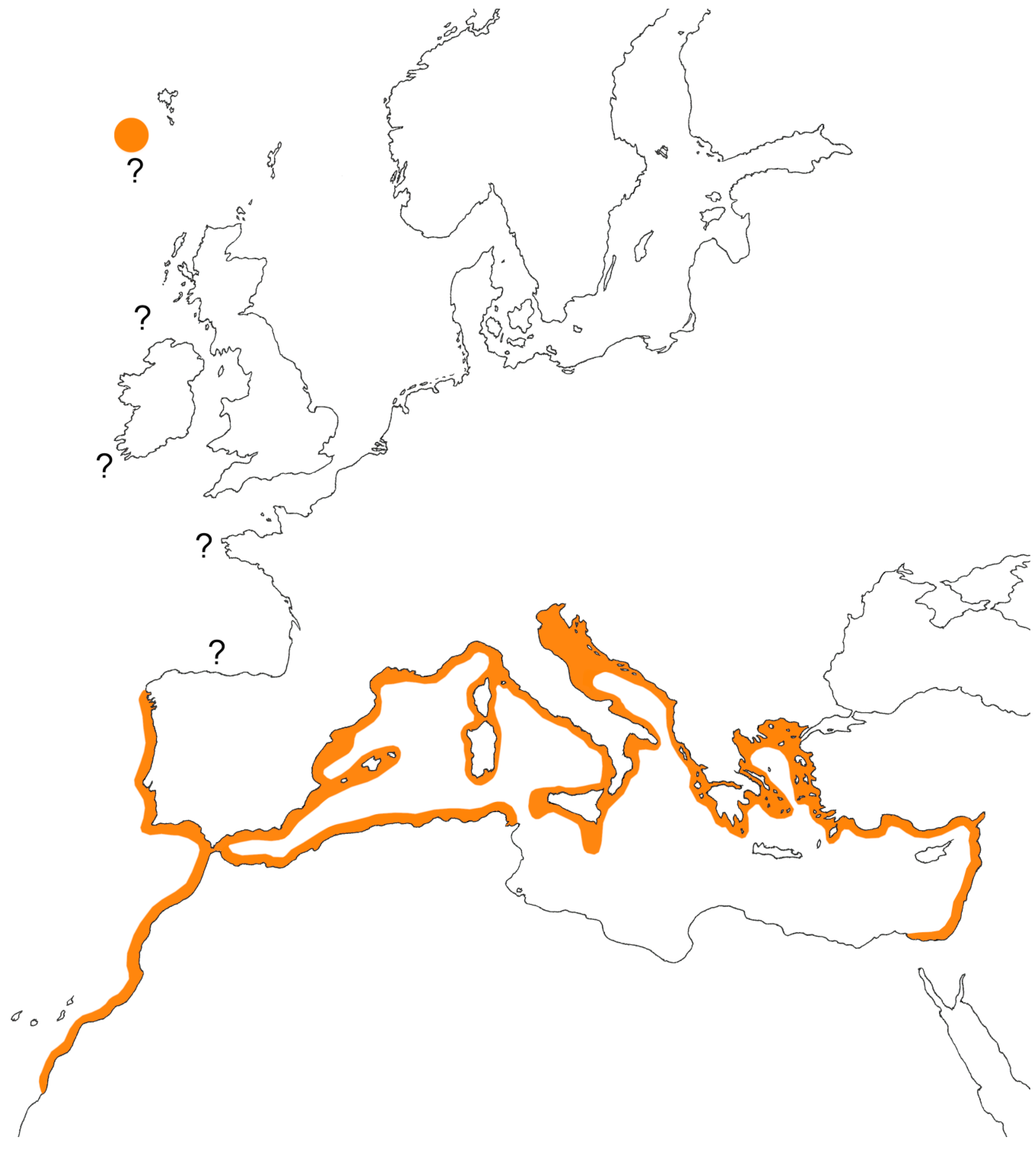

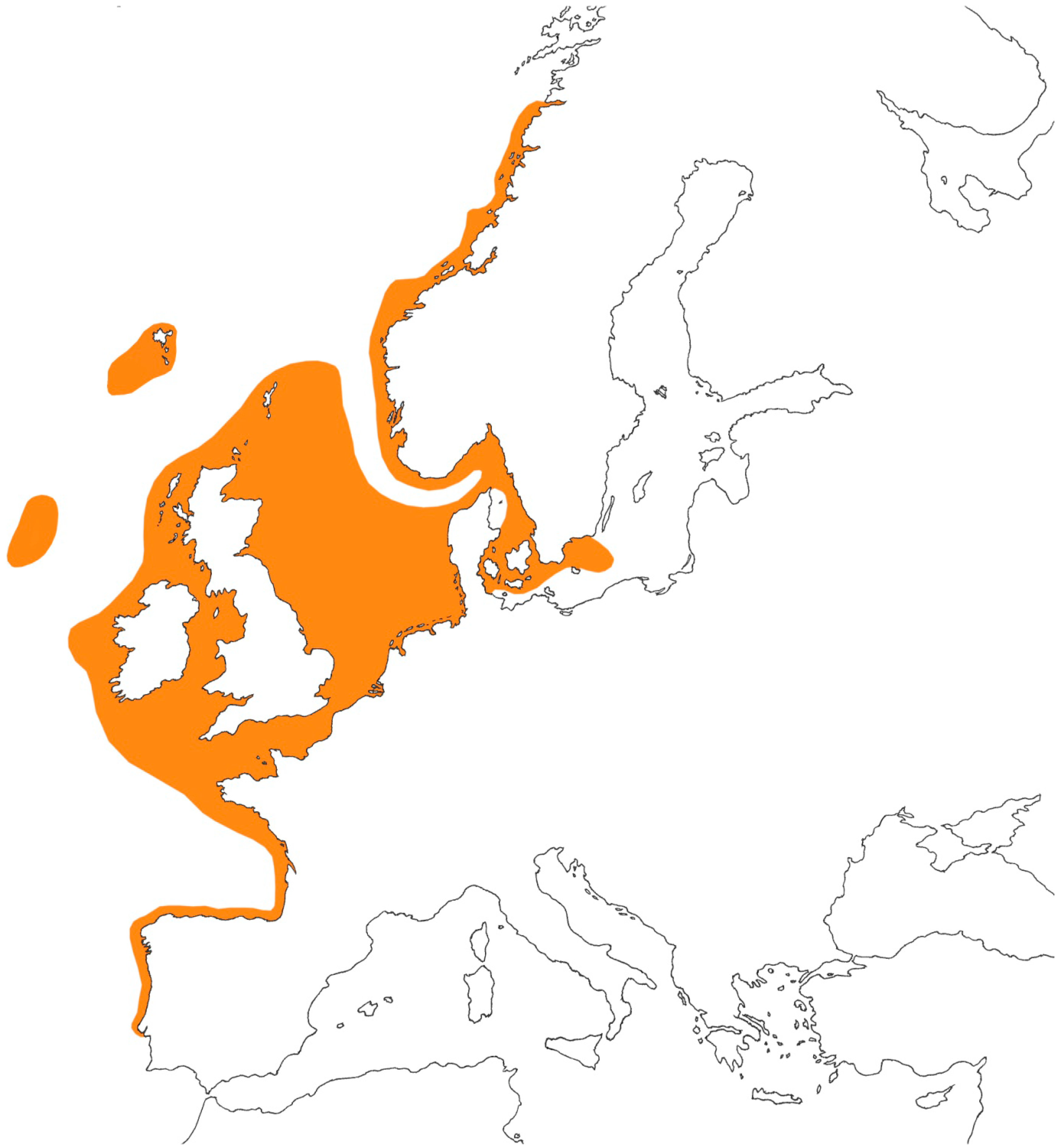
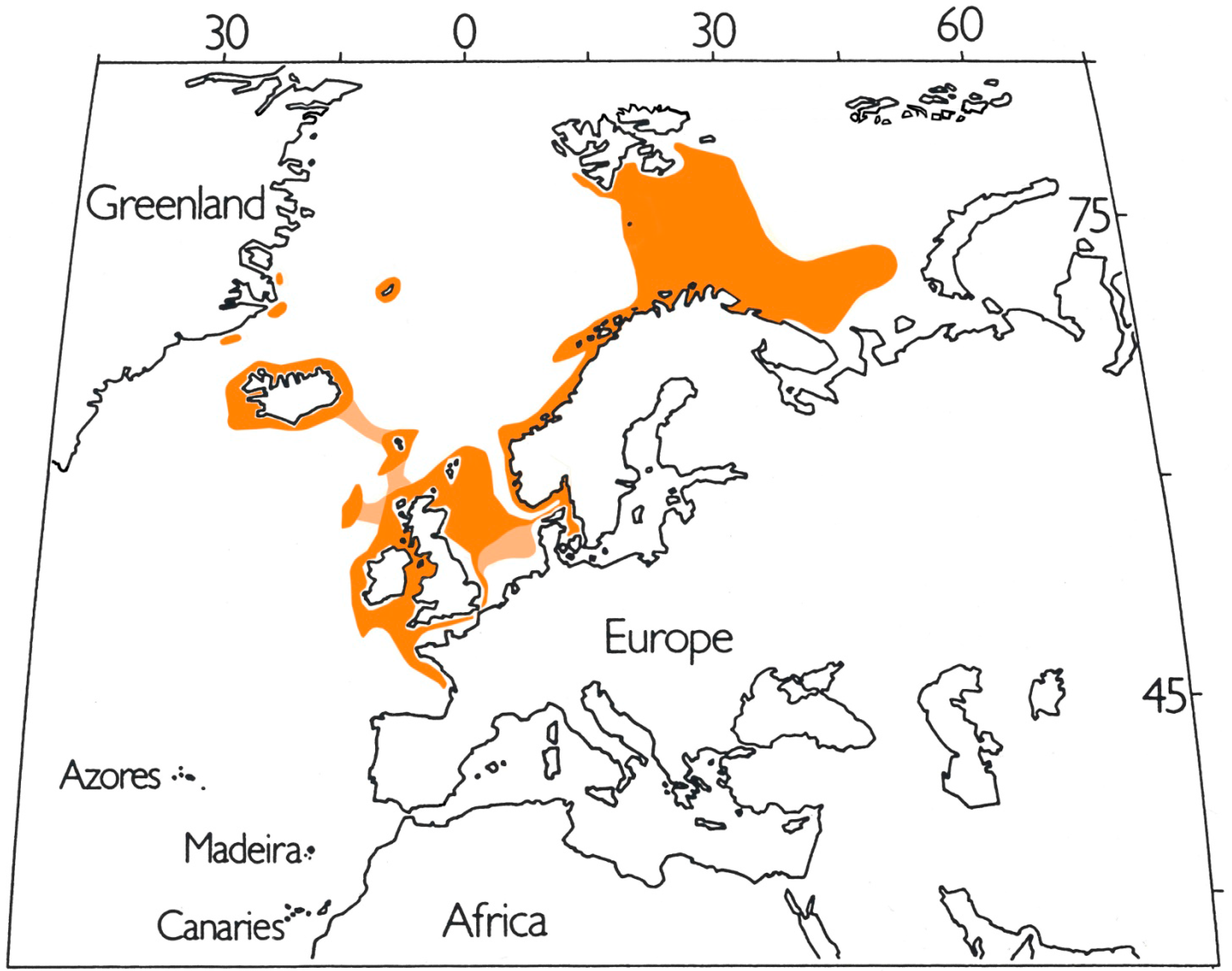
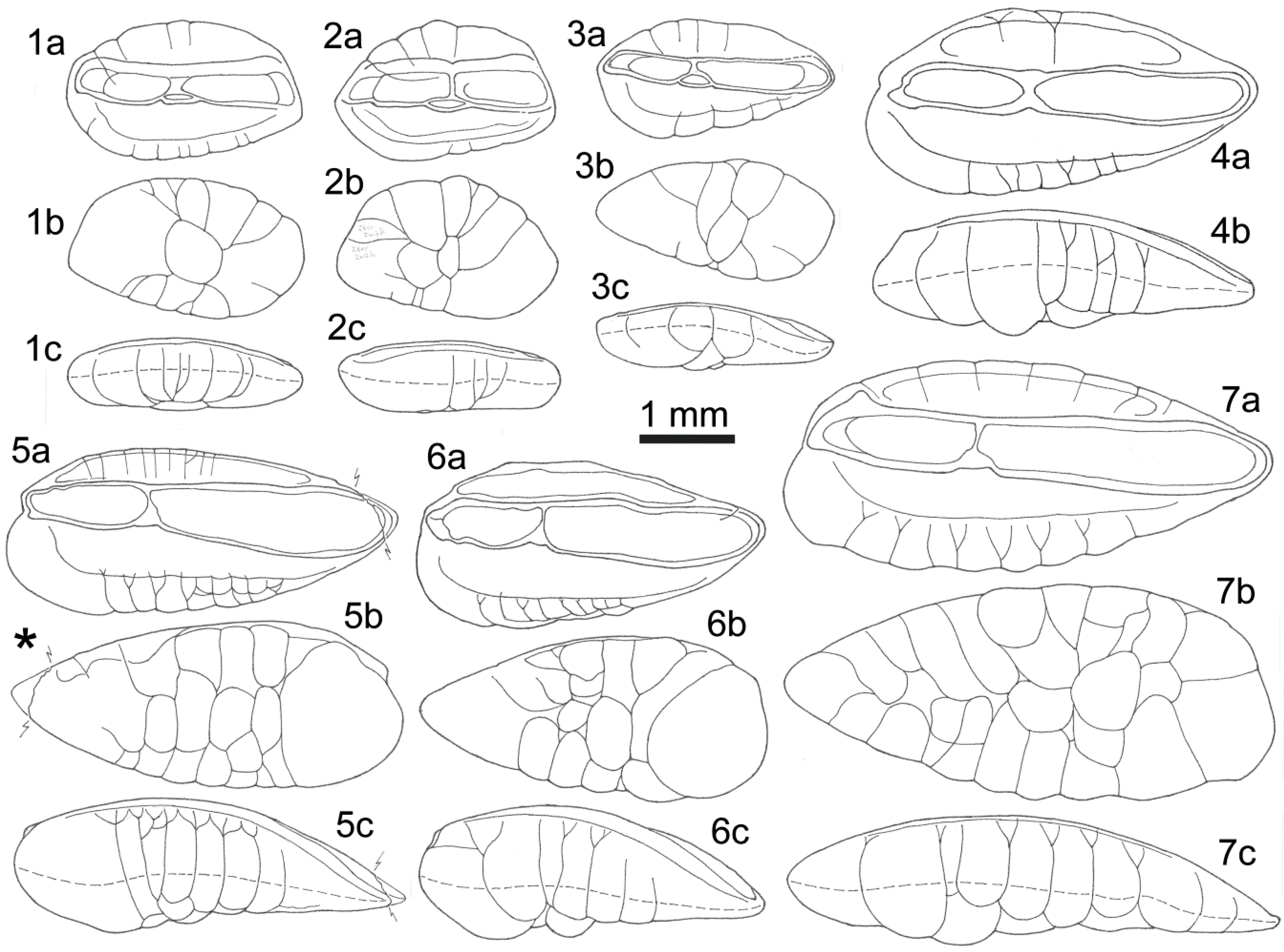
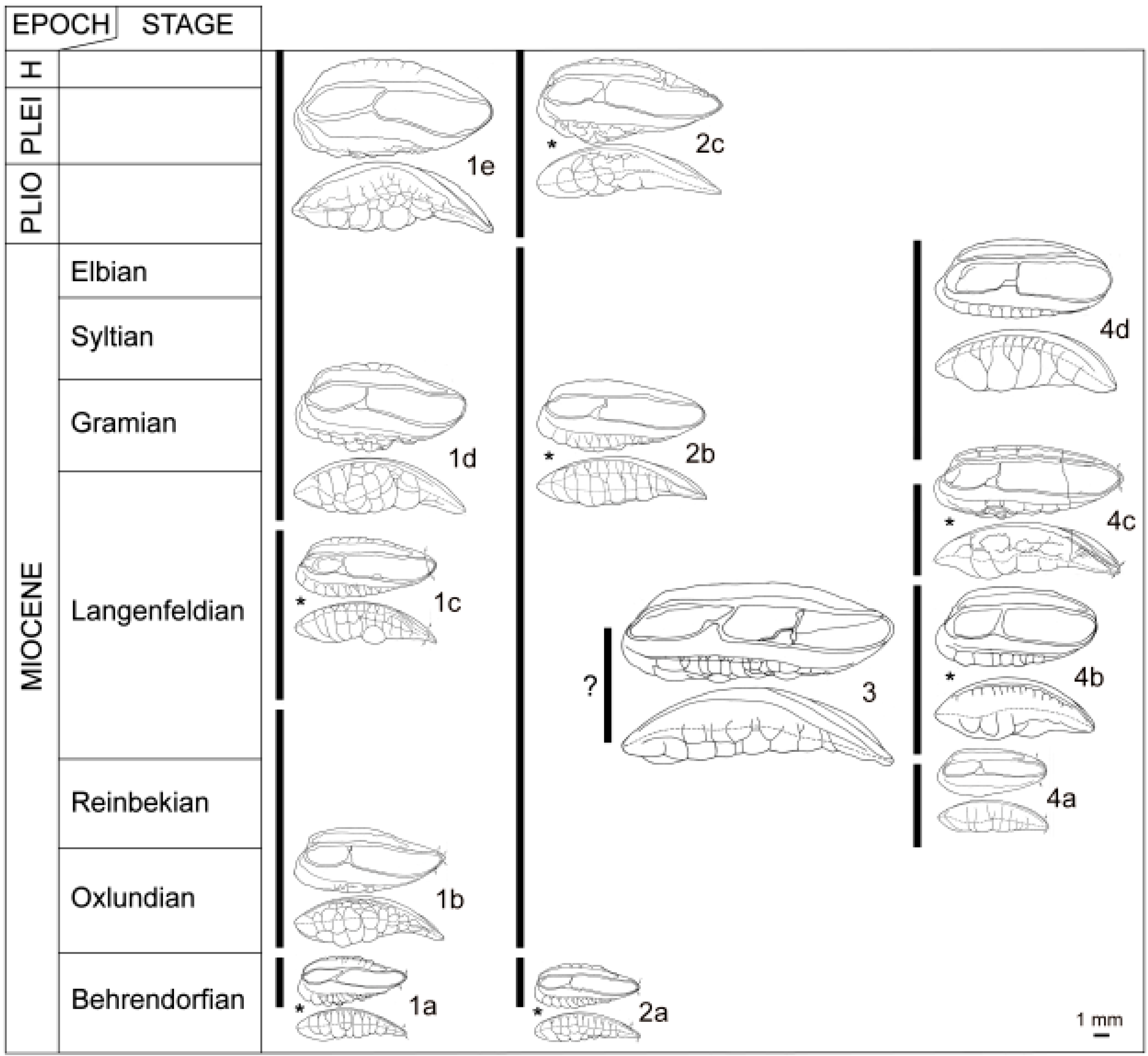
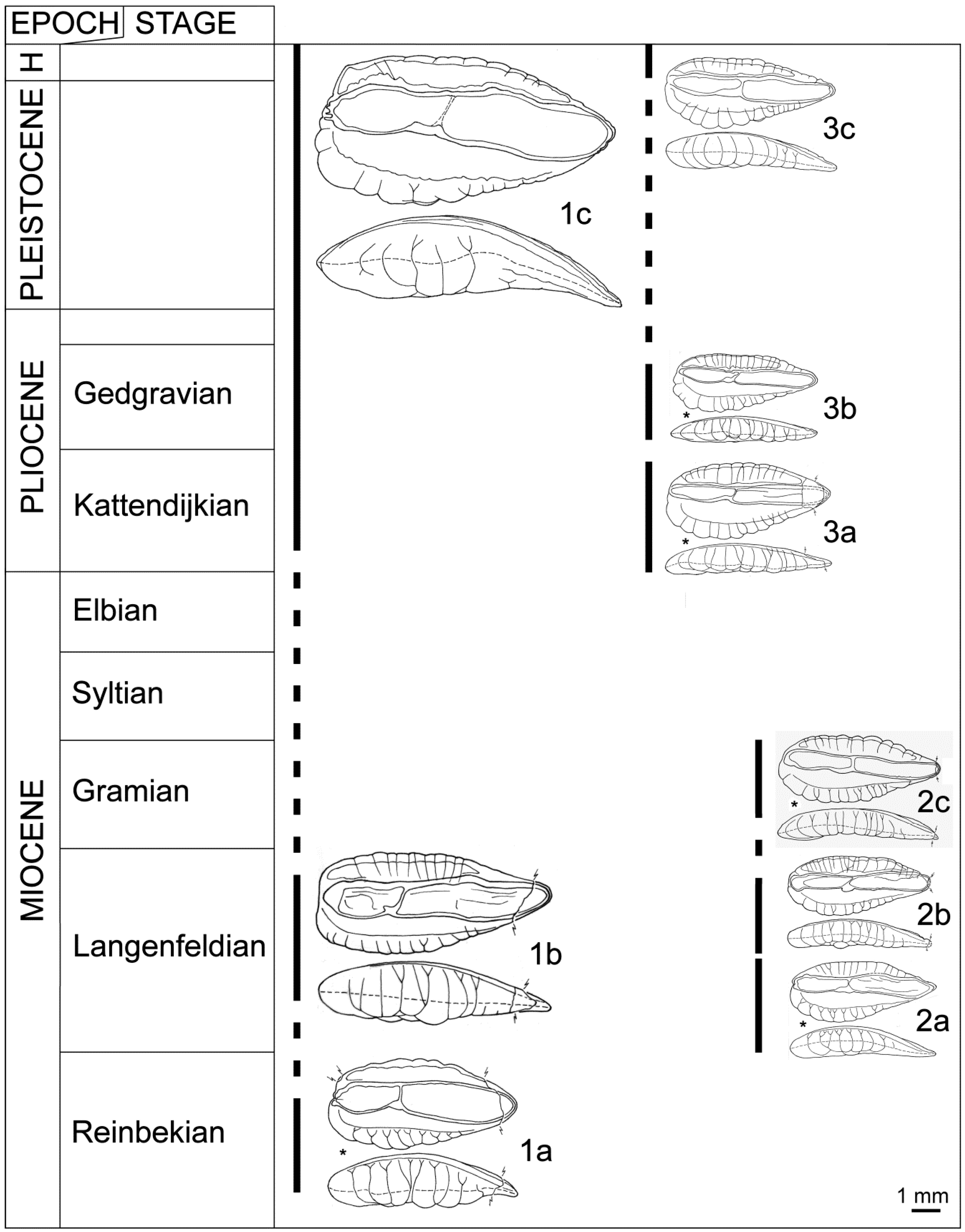
| Species | Age of Females When 50% Are Mature | Age of Males When 50% Are Mature | Maximum Known Age (Normal Max. Age) | TL of Females When 50% Are Mature (in mm) | TL of Males When 50% Are Mature (in mm) | Normal Maximum TL (in mm) | Extreme Maximum TL (in mm) | Maximum Observed OL (in mm) a |
|---|---|---|---|---|---|---|---|---|
| Neocolliolus esmarkii | 1.5 years b | 1.2 years b | 7 c (3 d–4 e) | 140 e | 150 e | 235 | 350 f | 9.07 (TL 205 mm) |
| Allotrisopterus minutus | 1.7 years g | 2.7 years g | 7 g (4–5) | 160–190 h | 140–200 h | 245 | 280 g | 11.68 (TL 269 mm) |
| Trisopterus luscus | 1.7 years i | 1.8 years i | 9 j (5) | 220 i,k 192 k | 234 i | 460 j | 490 l | 14.55 (TL 415 mm) |
| Trisopterus capelanus | end 1st year m | end 1st year m | 6 m,n (4) | 133 ° 138.2 p | 125 ° 123.9 p | 250 n | 320 q | 12.82 (TL 288 mm) |
| Species | Preferred Depth | Common Depth | Depth in Bays and Estuaries | Minimum Depth in Open Sea | Maximum Depth | Shoaling |
|---|---|---|---|---|---|---|
| Neocolliolus esmarkii | 100–200 m a Highest abundance I-group and older: 200 m b | 50–250 m (80–200 m c) | Few meters d | 40 m c | 560 m e | Very large shoals |
| Allotrisopterus minutus | 40–160 m f | 25–300 m c | 0.5 m g | 15 m h | 440 m i | Small shoals |
| Trisopterus luscus | 30–100 m j | 3–300 m c | Few meters d | 3 m c | 650 m | Small to large shoals |
| Trisopterus capelanus | 50–120 m k | 40–250 m l | 0 m m | 300 m n 310 m ° 450 m m | Small shoals |
| Neocolliolus esmarkii Lineage | Allotrisopterus minutus Lineage | Trisopterus luscus and T. capelanus Lineages |
|---|---|---|
| Otoliths flat or slightly curved lengthwise | Otoliths slightly curved or flat lengthwise | Otoliths clearly curved lengthwise |
| Inner surface slightly to moderately convex lengthwise and not twisted | Inner surface usually moderately convex and twisted | Inner surface strongly convex lengthwise and twisted |
| Postdorsal angle usually distinct | Postdorsal angle usually distinct | Postdorsal angle usually absent |
| Strongest ornamentation: low relief with low to very low knobs and shallow grooves | Strongest ornamentation: very high relief with protruding knobs and deep grooves | Strongest ornamentation: very high relief with protruding knobs and deep grooves |
| Frontal rim rounded | Frontal rim ± straight, nearly perpendicular to long axis | Frontal rim ± straight, obliquely running with respect to the long axis |
| Collum long, trapezoidal or ribbon like | Collum short, about triangular | Collum short, about triangular |
| Ostium slightly shorter than cauda | Ostium clearly shorter than cauda | Ostium clearly shorter than cauda |
| Cauda (nearly) straight | Cauda with S-curve | Cauda with S-curve |
| Ostial colliculum relatively long, also above collum where it narrows; its anterior part narrows too | Ostial colliculum relatively short, regularly oval-shaped | Ostial colliculum relatively short, regularly oval-shaped |
| Neocolliolus esmarkii | Other Recent Trisopterine Species |
|---|---|
| Streamlined, slender body shape with a lower head profile and deepest body part more backwards | Less streamlined body shape with a higher head profile and deepest body part more forwards |
| Lower jaw slightly longer than upper jaw | Upper jaw clearly longer than lower jaw |
| Chin barbel short and thin | Chin barbel long and thick |
| Pelvic fin relatively short | Pelvic fin relatively long |
| Pectoral fin relatively long | Pectoral fin relatively short |
| Dorsal and anal fins lower and more rounded | Dorsal and anal fins higher and more pointed |
| Short interspaces between the dorsal fins | No interspaces between dorsal fins |
| Eye relatively large | Eye relatively smaller |
| High number of gill rakers (33–43) | Low number of gill rakers (14–22) |
| Benthopelagic to mesopelagic | Demersal |
| Food: mainly planktonic crustaceans | Food: various infaunal and epifaunal (in)vertebrates |
| Meristics | N. esmarkii | A. minutus | T. capelanus | T. luscus |
|---|---|---|---|---|
| Number of vertebrae | 51–55 | 47–51 | 45–48 | 46–49 |
| Number of gill rakers | 33–37 | 24–28 | 15–21 | 18–23 |
| Number of dorsal fin pterygiophores | ||||
| 1st dorsal fin | 15–17 | 13–15 | 12–14 | 13–14 |
| 2nd dorsal fin | 26–28 | 24–28 | 18–23 | 22–25 |
| 3rd dorsal fin | 28–30 | 22–25 | 17–21 | 19–23 |
| 1st anal fin | 31–35 | 29–34 | 26–32 | 31–36 |
| 2nd anal fin | 27–30 | 23–25 | 17–22 | 19–22 |
| Ecological Zonation (Cadée, 1968) | Inner Central Bay | Marginal Shallow Zone | Middle Central Bay | Marginal Deep Zone | Outer Central Bay | Oceanic Zone | |||||||||||||
|---|---|---|---|---|---|---|---|---|---|---|---|---|---|---|---|---|---|---|---|
| Station | 87 | 88 | 47 | 116 | 13 | 51 | 172 | 246 | 186 | 475 | 479 | 579 | 721 | 931 | 771 | 775 | 841 | 900 | 901 |
| Depth in m | 7–8 | 10 | 7 | 12 | 54 | 24 | 8 | 15–35 | 18–20 | 60 | 35–38 | 35–40 | 50–60 | c. 62 | 68 | 50 | 40–55 | 85 | 60 |
| Trisopterus capelanus | 1 | 1 | 1 | 2 | 5 | ||||||||||||||
| Trisopterus luscus | 1 | 1 | 1 | 1 | 6 | 1 | |||||||||||||
| Allotrisopterus minutus | 1 | 1 | 1 | 1 | 2 | 1 | 2 | 24 | 2 | ||||||||||
| Merluccius merluccius | 1 | ||||||||||||||||||
| Aphia minuta | 1 | ||||||||||||||||||
| Lesueurigobius friesii | 2 | 4 | 1 | ||||||||||||||||
| Lesueurigobius sanzoi | 2 | ||||||||||||||||||
| Pomatoschistus minutus | 5 | 9 | |||||||||||||||||
| Thorogobius ephippiatus | 1 | ||||||||||||||||||
| Solea solea | 1 | ||||||||||||||||||
© 2017 by the author; licensee MDPI, Basel, Switzerland. This article is an open access article distributed under the terms and conditions of the Creative Commons Attribution (CC-BY) license (http://creativecommons.org/licenses/by/4.0/).
Share and Cite
Gaemers, P.A.M. Taxonomy, Distribution and Evolution of Trisopterine Gadidae by Means of Otoliths and Other Characteristics. Fishes 2016, 1, 18-51. https://doi.org/10.3390/fishes1010018
Gaemers PAM. Taxonomy, Distribution and Evolution of Trisopterine Gadidae by Means of Otoliths and Other Characteristics. Fishes. 2016; 1(1):18-51. https://doi.org/10.3390/fishes1010018
Chicago/Turabian StyleGaemers, Pieter A. M. 2016. "Taxonomy, Distribution and Evolution of Trisopterine Gadidae by Means of Otoliths and Other Characteristics" Fishes 1, no. 1: 18-51. https://doi.org/10.3390/fishes1010018
APA StyleGaemers, P. A. M. (2016). Taxonomy, Distribution and Evolution of Trisopterine Gadidae by Means of Otoliths and Other Characteristics. Fishes, 1(1), 18-51. https://doi.org/10.3390/fishes1010018




